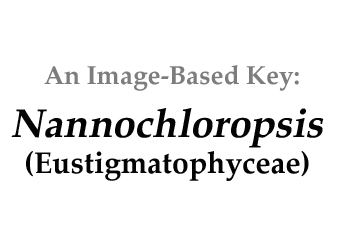|
|
||||
|
Click on images for larger format |
||||
Name derivation: |
||||
|
From the Greek nano- or nanno- small, -chloropsis green |
||||
Classification: |
||||
Nannochloropsis D.J. Hibberd 1981; Six of seven species descriptions are currently accepted taxonomically (Guiry and Guiry 2014.Order Eustigmatales; Family Eustigmatophyceae. |
||||
Morphology: |
||||
|
Unicells lacking flagella (no zoospores are produced), spherical to ovoid, 2 4 ΅m diameter. One plastid, no pyrenoid. |
||||
Similar genera: |
||||
|
Nannochloris (Chlorophyceae) looks similar at x400 x1000. Nannochloris occulata is considered to be synonymous with Nannochloropsis occulata (Ott and Oldham-Ott 2003). Chlorella (Chlorophyceae) also looks similar, but has a positive starch test.
|
||||
Commercial Use: |
||||
|
Used as food for microcrustaceans such as Daphnia in aquaculture because of its relatively rich storage of fatty acids (e.g. Omega-3). Example online. Chemical energy storage in chlorophyceae is mainly starch. Green mutants unable to produce starch shunt their photosynthate toward triglycerides, demonstrating a competition between the two storage products (Li et al. 2010.. Most non-green microalgae store lipids rather than starch, including the Eustigmatophyceae. Nannochloropsis spp. are of industrial interest because they have a high growth rate and produce triglycerides a.k.a. triacylglycerol (TAG). Given appropriate growth conditions, especially nitrogen deprivation, cellular lipid content can be > 50% of dry weight, compared to 30% in nitrogen-excess culture at 55 ΅mol photons m-2 s-1 (Jia et al. 2015). Two stage growth in ponds includes 1) N-surplus growth, followed by 2)onset of N-limitation. If sodium acetate is added at this stage as an organic C-supplement for mixotrophy, fatty acid accumulation is enhanced 300% from 10 to 30% dry weight at 55 ΅mol photons m-2 s-1 (Doan and Obbard 2014). In contrast to several N-depleted results referenced above, Rasdi and Qin (2014) found an increase in cellular fatty acids at high N:P ratio of 120:1 at 115 ΅mol photons m-2 s-1 (287 μM N; 2.4 μM P). Is there a possible link with higher illumination in this study? |
||||
Habitat: |
||||
|
Marine plankton.
|
||||
References: |
||||
|
Doan, Y.T.T. and J.P. Obbard 2014. Journal of Applied Phycology DOI 10.1007/s10811-014-0490-4 online. Graham, L. and L. Wilcox 2000. Algae. Prentice-Hall Guiry, M.D. and G.M. Guiry 2014. AlgaeBase. World-wide electronic publication, National University of Ireland, Galway. http://www.algaebase.org; searched on 12 December 2014. Hibberd, D.J. 1981. Notes on the taxonomy and nomenclature of the algal classes Eustigmatophyceae and Tribophyceae (synonym Xanthophyceae). Journal of the Linnean Society of London, Botany 82: 93-119 Jia, J., D. Han, H.G. Gerken, Y. Li, M. Sommerfeld, Q. Hu and J. Xu 2015. Molecular mechanisms for photosynthetic carbon partitioning into storage neutral lipids in Nannochloropsis oceanica under nitrogen-depletion conditions. Algal Research 7:66-77. Li, Y., D. Han, G. Hu, M. Sommerfeld and Q. Hu 2010. Inhibition of starch synthesis results in overproduction of lipids in Chlamydomonas reinhardtii. Biotechnology and Bioengineering 107(2):258-266. Ott, D.W., and C.K. Oldham-Ott 2003. Eustigmatophyte, Raphidophyte, and Tribophyte algae. In: Freshwater Algae of North America, J.D. Wehr and R.G. Sheath (Eds). Chapter 11. Rasdi, N.W. and J.G. Qin 2014. Effect of N:P ratio on growth and chemical composition of Nannochloropsis oculata and Tisochrysis lutea. Journal of Applied Phycology DOI 10.1007/s10811-014-0495-z online. |
||||
|
Home / Eustigmatophyceae / Nannochloropsis |
||||




